 W
WMorwong is a genus of fishes belonging to the family Latridae found in oceans off Australia and New Zealand. They were formerly included in the genus Cheilodactylus in family Cheilodactylidae, but based on genetic and morpological analyses they have been moved to genus Morwong in family Latridae.
 W
WThe eastern angelshark is an angelshark of the family Squatinidae.
 W
WAcanthopagrus australis, the yellowfin bream, also known as sea bream, surf bream, silver bream or eastern black bream, is a species of marine and freshwater fish of the porgy family, Sparidae. It is a deep-bodied fish, occasionally confused with Acanthopagrus butcheri, but is generally distinguished by its yellowish ventral and anal fins. It is a popular target for recreational fisherman due to its capacity to fight well above its weight coupled with its table quality.
 W
WCampichthys tryoni is a species of marine fish of the family Syngnathidae. Little is known of this species, but the specimens that have been collected were found on the Queensland coast off of northeastern Australia. It is a rare mainly tan coloured pipefish with brownish markings, it has a white blotch over the eyes, a pale patch above the operculum and it has small white dots along its back and tail. The males frequently show irregular dark barring along their ventral surface. This species is ovoviviparous, with males carrying eggs in a brood pouch until giving birth to live young. The largest known specimen is 7.2 centimetres (2.8 in) long, while males may brood at roughly 6–6 centimetres (2.4–2.4 in). The species was described by James Douglas Ogilby in 1890 from a specimen collected in Moreton Bay, Queensland in 1886 and the specific name honours his friend, Mr Henry Tryon, with whom he enjoyed a collecting trip in Moreton Bay. It is a listed Marine species in Australia under the Environment Protection and Biodiversity Conservation Act 1999.
 W
WThe collared carpetshark is a poorly understood species of carpetshark of the family Parascylliidae endemic to the waters of eastern Australia between latitudes 26°S and 38°S. It is typically found 55–128 m (180–420 ft) in depth near the floor of rocky reefs on the continental shelf, though its depth range can extend between 20 and 230 m. At a maximum length of only 85 cm (2.79 ft), it poses no threat to humans. It is common within its range and is not targeted species. This, combined with high survival rates after discardment and a significant portion of habitat untouched by fishing are why it is listed as Least Concern by the International Union for the Conservation of Nature (IUCN). Reproduction is oviparous and embryos feed solely on yolk.
 W
WThe orange-spotted catshark or rusty catshark, is a species of catshark, and part of the family Scyliorhinidae. It is found only off the coast of Western Australia, at depths between 25 and 540 m. Its length is up to 39 cm (15 in).
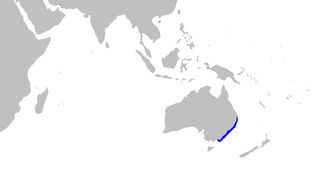 W
WThe Australian spotted catshark is a catshark of the family Scyliorhinidae, found only around Australia between 32 and 38°S, at depths between 10 and 180 m. It can grow up to 90 cm. Females of this species were observed as being reproductive year round. They are also confirmed as being a single oviparous species.
 W
WThe Barrier Reef chromis, also known as the yellowback puller or shining puller, is a species of damselfish in the family Pomacentridae native to the east coast of Australia. It is a small fish with a yellowish-brown dorsal surface separated by a dark stripe from its silvery flanks and underside.
 W
WThe velvet dogfish the only member of the genus Zameus, is a harmless sleeper shark of the family Somniosidae, found around the world between latitudes 64°N and 48°S, from the surface to 2,000 m. Its length is up to 84 cm. Although sharks within the family Somniosidae have generally been accepted to be non-luminous, Zameus squamulosus has photophores on its ventral epidermis.
 W
WThe longnose velvet dogfish is a sleeper shark of the family Somniosidae, found circumglobally in southern hemisphere subtropical seas, at depths of between 230 and 1,500 m. It reaches a length of 130 cm.
 W
WThe mud flathead is a species of flathead endemic to the Pacific coastal waters of Australia where it occurs at depths of from 15 to 53 metres on the continental shelf. This species grows to a length of 12.1 centimetres (4.8 in) SL. This species is the only known member of its genus.
 W
WThe eastern frogfish is a bottom-dwelling fish endemic to coastal eastern Australia, from Fraser Island, Queensland to Kiama, New South Wales. It is an ambush predator with a large expandable stomach, capable of swallowing crustaceans, molluscs and other fishes whole.
 W
WMugilogobius stigmaticus, commonly known as blackspot mangrove goby, is a species of goby native to the waters of eastern Australia.
 W
WThe eastern blue groper is a species of wrasse native to southeastern Australia from Hervey Bay in southern Queensland to Wilsons Promontory in Victoria. They occur in coastal waters, preferring rocky areas at a depth of about 40 m (130 ft). Juveniles inhabit beds of seagrass in estuaries. The diet of this species consists of invertebrates such as various molluscs, crabs, sea urchins, and cunjevoi. This species grows to a length of 72 cm (28 in) as adult males, while females are less than 60 cm (24 in) long. This species was sometimes sought as a game fish but this is now banned in New South Wales. In 1998, the eastern blue groper was made the state fish emblem of New South Wales.
 W
WThe broadgilled hagfish or New Zealand hagfish is a hagfish found around New Zealand and the Chatham Islands as well as around the south and east coasts of Australia, at depths between 1 and 900 metres.
 W
WThe Kidako moray is a species of marine fish in the family Muraenidae.
 W
WThe red morwong is a morwong, a species of fish found off southeast Australia and the North Island of New Zealand from shallow depths to at least 55 m, on rocky reef and coastal areas. Its length is between 30 and 60 cm.
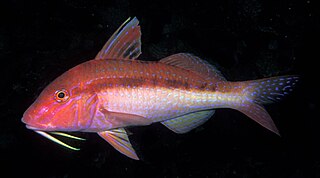 W
WUpeneichthys lineatus, also known as the blue-striped mullet, blue-lined goatfish. blue-striped goatfish, blue-spotted goatfish and blue striped red mullet, is a species of marine ray-finned fish, a goatfish from the family Mullidae. It is native to the Pacific coast of Australia. It occurs in sheltered areas over rocky and sandy substrates and can be found 5 to 100 metres, though rarer below 40 metres (130 ft). This species can reach a length of 40 centimetres (16 in) FL. This species is commercially important.
 W
WThe eastern nannygai, also known as the redfish, bight redfish, red snapper, golden snapper or koarea, is an alfonsino of the genus Centroberyx. It is found around Australia and New Zealand at depths between 10 and 450 metres on the continental shelf. It can reach lengths of up to 51.0 centimetres (20.1 in) SL. It forms schools near the sea floor over rocky reefs and mud at dawn and dusk, splitting up at night to feed on mollusks, crustaceans, and small fish. Its young live in estuaries and shallow coastal waters.
 W
WThe parore also known as luderick, black bream or blackfish is a species of marine ray-finned fish, a sea chub from the family Kyphosidae which is found in the southwestern Pacific Ocean off Australia and New Zealand. Parore or paraore is the common name in New Zealand but in Australia luderick is preferred.
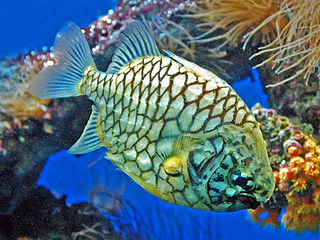 W
WThe pineapplefish is a species of fish in the family Monocentridae, and the sole member of its genus. It is also known as the knightfish or the coat-of-mail fish, due to the armor-like scales covering its body, and the port-and-starboard light fish, as it has a pair of bioluminescent organs that are reminiscent of navigation lights on ships. Its specific epithet is from the Latin gloria and maris, meaning "glory of the sea".
 W
WThe dusky flathead or black flathead is a large predatory fish and the largest member of the family Platycephalidae. Dusky flathead are a largely estuarine species and are found in estuaries, estuarine lakes and coastal bays on the east coast of Australia, from Cairns in Queensland to the Gippsland Lakes in Victoria. They occur over sand, mud, gravel and seagrass and can inhabit estuarine waters up to the tidal limit.
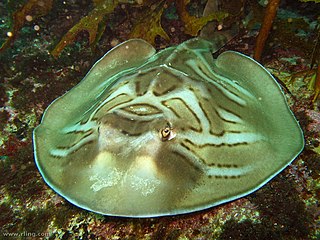 W
WThe eastern fiddler ray, also called the banjo shark, fiddler ray, fiddler, green skate, magpie fiddler ray, parrit, southern fiddler ray or southern fiddler, is a species of fish in the Rhinobatidae family. It is endemic to eastern Australia. Its natural habitat is open seas.
 W
WThe goblin shark is a rare species of deep-sea shark. Sometimes called a "living fossil", it is the only extant representative of the family Mitsukurinidae, a lineage some 125 million years old. This pink-skinned animal has a distinctive profile with an elongated, flat snout, and highly protrusible jaws containing prominent nail-like teeth. It is usually between 3 and 4 m long when mature, though it can grow considerably larger such as one captured in 2000 that is thought to have measured 20 ft. Goblin sharks are benthopelagic creatures that inhabit upper continental slopes, submarine canyons, and seamounts throughout the world at depths greater than 100 m (330 ft), with adults found deeper than juveniles. Some researchers believe that these sharks could also dive to depths of up to 1300 m for short periods of time.
 W
WThe smallfin gulper shark is a medium-sized deepwater dogfish in the family Centrophoridae.
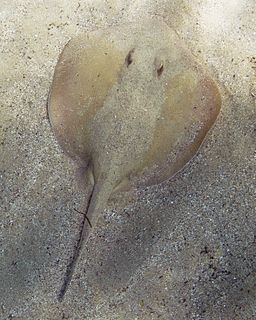 W
WThe common stingaree is a species of stingray in the family Urolophidae. The most abundant ray in inshore waters off eastern Australia, it generally inhabits estuaries, sandy flats, and rocky reefs from the shore to a depth of 60 m (200 ft). This plain brownish to grayish species has a rounded pectoral fin disc with a broadly triangular snout. Its nostrils have enlarged lobes on their outer margins and a skirt-shaped curtain of skin with a fringed posterior margin between them. Its tail bears a small dorsal fin before the stinging spine, and terminates in a leaf-shaped caudal fin. This ray can grow to 52 cm (20 in) long.
 W
WThe Kapala stingaree is a species of stingray in the family Urolophidae, endemic to inshore waters off southeastern Queensland and New South Wales. It is commonly found on and around rocky reefs at a depth of 10–130 m (33–427 ft). Reaching 51 cm (20 in) in length, the Kapala stingaree has a rounded, diamond-shaped pectoral fin disc and a slender tail, which ends in a leaf-shaped caudal fin and bears lateral skin folds and a small dorsal fin in front of the stinging spine. It has a distinctive bell-shaped curtain of skin between its nostrils. This species is greenish above, with a highly variable pattern of dark markings usually found outside and between the eyes, and over the back and tail.
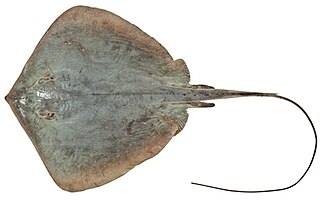 W
WThe estuary stingray, also called the estuary stingaree or brown stingray, is a species of stingray in the family Dasyatidae. Endemic to eastern Australia, it typically inhabits shallow, mangrove-lined tidal rivers, estuaries, and bays in southern Queensland and New South Wales. This yellow-brown to olive ray grows to at least 93 cm (37 in) across. It has a diamond-shaped pectoral fin disc and a mostly smooth, whip-like tail bearing both dorsal and ventral fin folds. It can additionally be identified by its long, narrow nostrils and the row of thorns along the midline of its back.
 W
WChelmonops truncatus, the eastern talma or truncate coralfish, is a species of marine ray-finned fish, a butterflyfish from the family Chaetodontidae. It is endemic to Australia.
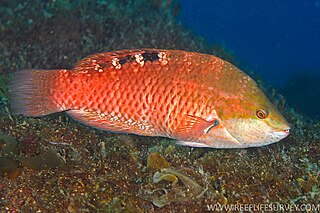 W
WThe orange wrasse is a species of wrasse native to the Pacific Ocean from Australia to New Zealand and the Kermadec Islands. It is found in inshore waters at depths of from 10 to 50 metres. It can reach a length of 17 centimetres (6.7 in) SL. It can also be found in the aquarium trade.